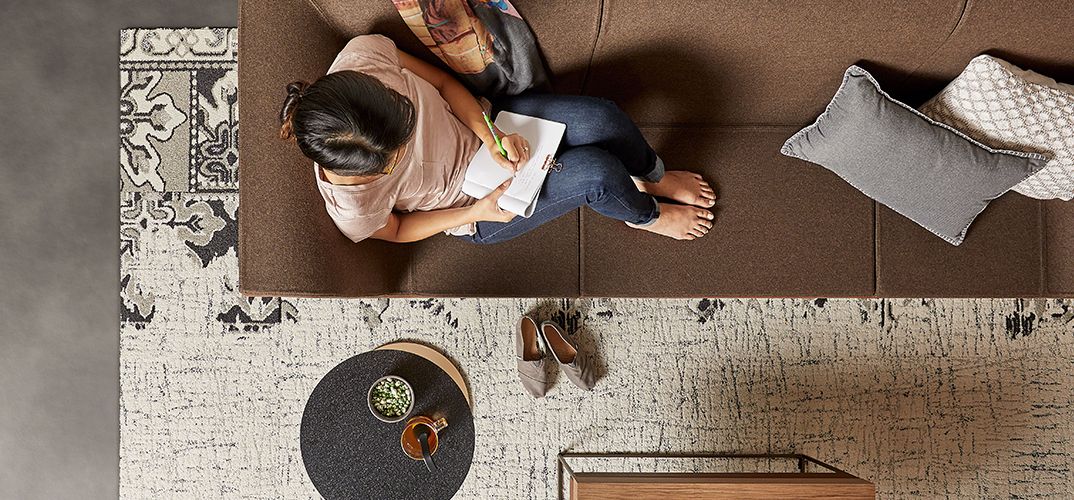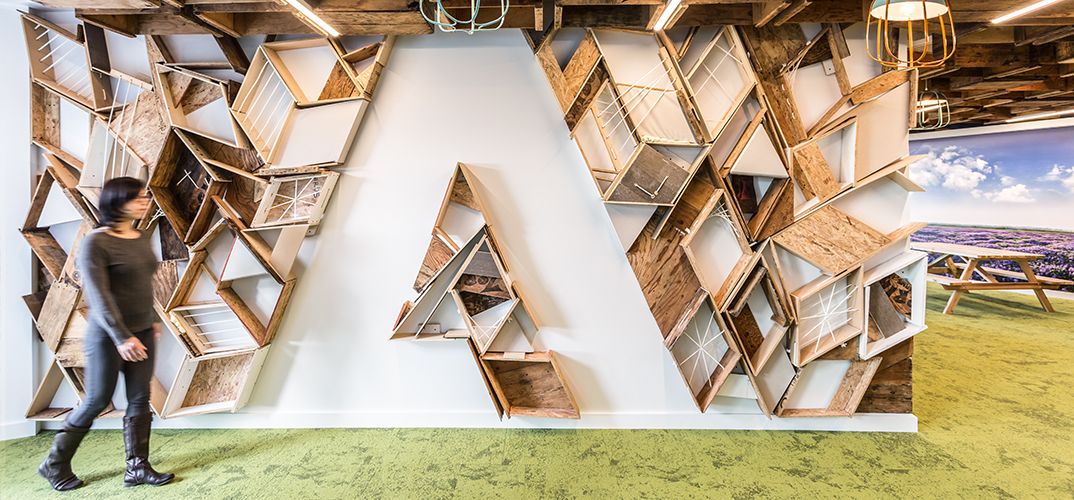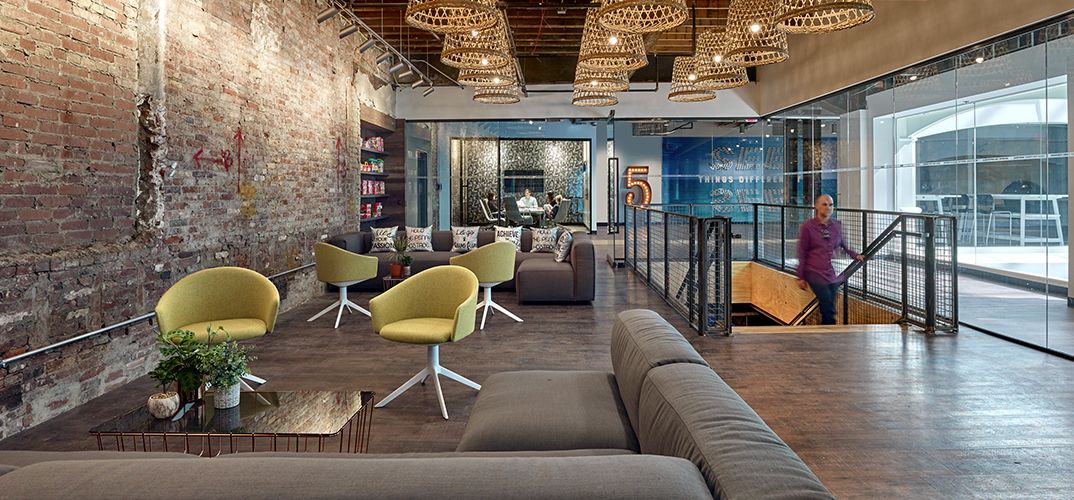What makes a well-designed space?
It’s a question that prompts many answers. Maybe you’re thinking about how it promotes the work or activity at hand. Or one that’s healthy for the occupants and the environment. Or, perhaps it’s a space that deftly balances the needs of those using it with the costs of creating it.
Ultimately, the goal of an interior environment is to move forward the intention of a space and engage the user in meaningful ways. One way to do that is by designing spaces to activate the five basic senses: sight, sound, touch, smell, and taste.

Sensory connections and our relationship to them hold meaning and help shape our sense of self (Product Shown: FLOR Turkish Smoke, Turkish Blend, and Turkish Bloom). Photo courtesy of Steelcase.
The importance of engaging the senses
Have you ever experienced that surprising moment of déjà vu when the whiff of a familiar scent or the first few bars of a song on the radio evoke an unexpected emotion or call back a distant memory?
As individuals, we intake information through our senses, creating awareness (perception). Then, we process that information into our understanding (cognition), which in turn shapes our reality. We spend our early years trying to “make sense” of the world—seeing, touching, smelling, tasting and listening to what’s around us. The multi-sensory connections that form in our brain allow us to create meaning and memory.1
Although we tend to consider our senses individually, they actually work in tandem. An introductory essay to Cooper Hewitt’s exhibition The Senses: Design Beyond Vision explains this phenomenon. “People perceive objects and spaces with sound and touch as well as with vision. People experience sound by feeling vibrations and seeing movements as well as hearing by ear.” The more senses we engage, the more strongly we are tied to a moment, an object, a space. As a result, design is evolving to incorporate sensory experience into the places where we live and work.

The shape and ethos of an interior environment influences the perception, experience and well-being of employees and culture (Product Shown: Interface Urban Retreat UR103). Photo by Emily Hagopian
Where science and design connect
You can influence how people feel within a space through its physical design. The physical aspects of a space not only prompt how we move but also create a mood, or energy, that is perceived by our brains—both consciously and unconsciously. This perception is then processed into our sense of self and our bigger experience within an environment.
To create a meaningful experience for people in a space, you must design to engage the mind (perception and cognition) and the body (the “physical” senses) with an intentionally designed environment. Think of it as a simple equation:
Mind + Body + Environment = Experience
This is the intersection of neuroscience, psychology, and design—research is now beginning to prove what we as designers understand around how people engage with their environments. Namely, that people are influenced by what they see, what they hear, what they touch, what they smell, and what they taste. These multi-sensory experiences inspire stronger, more memorable reactions.
An excellent example of this science/design intersection: Google’s own A Space for Being at this year’s Milan Design Week. The interactive installation consisted of three rooms with distinctly different sensory experiences; as people moved throughout each space, a wearable sensory band recorded their physiological responses. This allowed researchers to quantify a person’s conscious response to each room alongside their unconscious bodily response. Google’s experiment is a step forward in developing a deeper understanding of how design choices affect perception of a space.
“Architecture is the art of reconciliation between ourselves and the world, and this mediation takes place through the senses.” – Juhani Pallasmaa
How to design for the senses
Our brains constantly crave stimulation. It’s why we love being out in nature, with its endless variation of sights and smells and sounds. Not only is it sensory heaven; it’s mentally and physically restorative.
But given that we spend about 90% of our time indoors1, designers and architects have a responsibility to make our interior environments just as healthy and just as stimulating. So how do you do that?
It comes down to a human-centered design approach.
In workspaces specifically, people are most likely to engage their surroundings through sight, sound and touch. Consider the shape of a space, the color of a wall, the light from a window, the comfort of a textile, the sound of a floor. Each of these moments are key opportunities to think about the sensory signals of a space and what experience you want people to have. Is it meant to be active and collaborative? Quiet and calming? This will influence what materials you use within the workplace to create meaning and mood—the foundation for elements like brand, culture and employee well-being.

Thoughtful material selection mediates our inner and outer experience by hearkening a mood, stimulating with visual interest and even balancing through acoustical comfort (Product Shown: Interface LVT, Level Set Textured Woodgrains).
Choosing the right materials
Sight is probably the sense we lean on the most. When we look at a piece of furniture, for example, we can tell a lot of things about it. We can tell whether it’s aesthetically pleasing. We can get an idea if it’s of good quality or not. We can anticipate how it might behave when we use it.
Our sense of touch will inform us in much the same way. We can feel whether a carpet is plush or flat as we walk across it. We can tell whether a chair is comfortable or not after settling in for just a few seconds.
And of course, we can hear the differences in materials when we walk into a room. A space with lots of texture is quieter to our ears than an open space with clean, shiny surfaces.
Each of those sensory inputs will inform our feelings about a space and whether we’ll use it for its intended purpose.

Multi-sensory connections can be used as a functional design tool to create a more human-centric experience (Product Shown: FLOR Roadside Attraction). Photo courtesy of Steelcase.
So, when you’re choosing materials for a project, maybe ask yourself some of the following questions:
- Does this material enrich the intent and experience of the space?
- How does it stimulate multiple senses?
- How will people engage with it?
- How will this material behave and perform?
- How will it work with other materials you’ve chosen?
- How will it interact with natural elements (light, air, sound, temperature) in the space throughout the day?
- How does it contribute to the physical and emotional experience of the user?
Our understanding of the built environment and its impact on the nervous system is evolving at a revolutionary pace. So, use your understanding of sensory experiences as a functional tool to influence how people perceive space. Elevate your design approach to create spaces and choose materials with the human experience in mind. It will make your design not only more beautiful but also more “sensible.”
1 Why Sensory Design? (2018) [blog post] Available at: https://www.cooperhewitt.org/2018/04/03/why-sensory-design/
2 U.S. Environmental Protection Agency. 1989. Report to Congress on indoor air quality: Volume 2. EPA/400/1-89/001C. Washington, DC.
6 responses to “How Engaging the Senses Creates Meaningful Design”
Finally a real essay on Interior Design. This is so much about what my mentor Morris Lapidus taught me about designing space. So many articles on ID don’t provide the real essence about understanding our trade.
Great blog, Mindy! I referenced that Google space at Milan Design Week in a blog I wrote as well 🙂
Quick point about hospitality — hotels have long ago taken the lead on designing with all the senses in mind. It will be interesting to see how other verticals take sense into consideration in the future. Thank you for sharing!
Please note that not everybody’s senses are not the same. You can’t just design for neurotypicals. There are those that are unable to sense things and those who are hypersensitive. Design for the users. Play to the audience, which is not homogeneous!
Thank you for joining the conversation, B. You emphasize a very important point that is essential to good design. In part, my motivation and perspective for the article comes from my own family’s experience with hypersensitivity to one’s surroundings. Not only the negative side, but also the promising side of sensory experience when used appropriately. We must continually ask the question, as I conclude in the article, how do space and materials contribute to the physical and emotional experience of the user? As designers, we have an obligation to make our interior environments healthy for all participants.
JUST WOW… NO WORDS TO SAY ABOUT..
I AM ARCHITECTURE STUDENT NOW I AM FINAL YEAR
ITS USEFUL FOR ALL
THANK YOU SO MUCH AND ALSO NIPPON PAINT INDIA
FAITHFUL
HK
@_hk_arts_ (Instagram)
HUSNA KALSOOM.P.P (FB)
You did a great job on this article. Keep posting content like this.